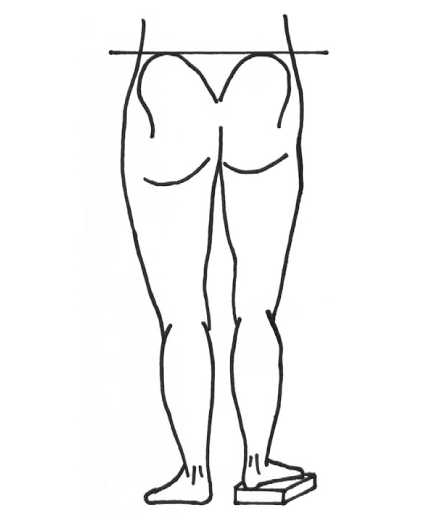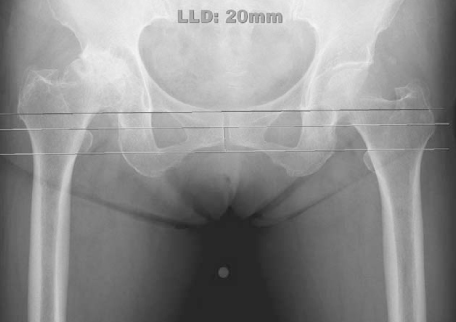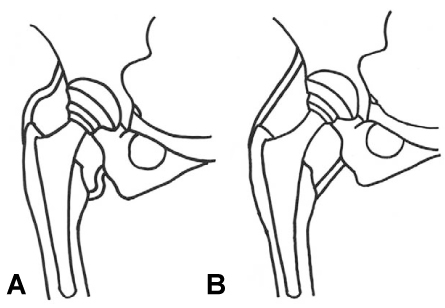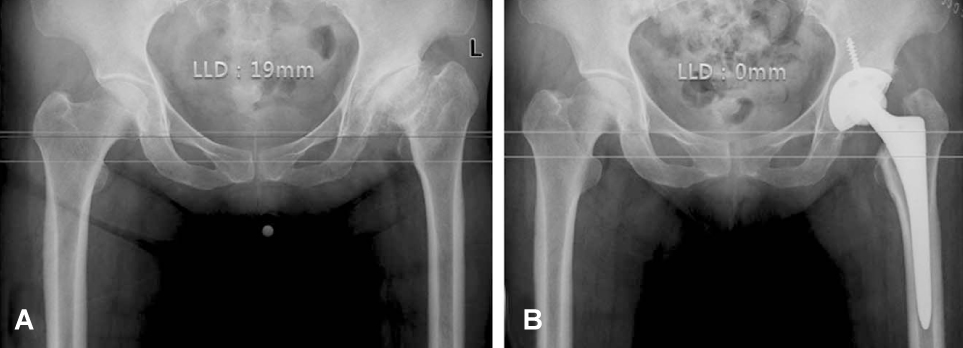J Korean Hip Soc.
2010 Mar;22(1):20-26. 10.5371/jkhs.2010.22.1.20.
Leg Length Discrepancy after Total Hip Arthroplasty
- Affiliations
-
- 1Department of Orthopedic Surgery, Pusan National University School of Medicine, Yangsan, Korea. kuentak@pusan.ac.kr
- KMID: 1461073
- DOI: http://doi.org/10.5371/jkhs.2010.22.1.20
Abstract
- Restoration of the hip biomechanics, including the femoral offset and leg length, are the desired goals when performing total hip arthroplasty. A leg length discrepancy following total hip arthroplasty is a significant source of back pain and sciatica, gait disorders, general dissatisfaction and dislocation. Significant lengthening of the leg can be a risk factor for nerve injury and it is a relatively common cause of litigation. There is a fundamental interrelationship between leg length and stability when performing hip arthroplasty. There are a multitude of situations in which achieving both stability and perfectly equal leg lengths is simply not possible. Stability is the primary objective, and the surgeon may need to sacrifice leg length equality on the altar of stability. Although a leg length discrepancy cannot be eliminated after hip arthroplasty, it can be minimized through a series of steps, including a physical examination, radiographic evaluation, preoperative templating and intraoperative confirmation of the preoperative plan.
MeSH Terms
Figure
Cited by 2 articles
-
Useful Method for Minimizing Leg Length Discrepancies in Hip Arthroplasty: Use of an Intraoperative X-ray
Jong Won Kim, Young Soo Jang, Hyun Soo Park, Jong Deuk Rha, Jin Phil Yang, Jae Hyuk Choi, Sung Ju Bae
J Korean Hip Soc. 2011;23(4):262-267. doi: 10.5371/jkhs.2011.23.4.262.Ceramic on Ceramic Cementless Total Hip Arthroplasty with a 36 mm Diameter Femoral Head - More than Three Years Follow up -
Suk Kyu Choo, Hyoung Keun Oh, Si Hoon Yoo, Ji Ho Nam
Hip Pelvis. 2013;25(2):95-101. doi: 10.5371/hp.2013.25.2.95.
Reference
-
1. Austin MS, Hozack WJ, Sharkey PF, Rothman RH. Stability and leg length equality in total hip arthroplasty. J Arthroplasty. 2003. 18:Suppl. 88–90.
Article2. Bose WJ. Accurate limb-length equalization during total hip arthroplasty. Orthopaedics. 2000. 23:433–436.3. Edeen J, Sharkey PF, Alexander AH. Clinical significance of leg-length inequality after total hip arthroplasty. Am J Orthop. 1995. 24:347–351.4. Hoikka V, Santavirta S, Eskola A, Paavilainen T, Wirta J, Lindholm TS. Methodology for restoring functional leg length in revision total hip arthroplasty. J Arthroplasty. 1991. 6:189–193.
Article5. Ranawat CS, Rodriguez JA. Functional leg-length inequality following total hip arthroplasty. J Arthroplasty. 1997. 12:359–364.
Article6. Sarangi PP, Bannister GC. Leg length discrepancy after total hip replacement. Hip International. 1997. 7:121–124.
Article7. Suh KT, Cheon SJ, Kim DW. Comparison of preoperative templating with postoperative assessment in cementless total hip arthroplasty. Acta Orthop Scand. 2004. 75:40–44.
Article8. Turula KB, Friberg O, Lindholm TS, Tallroth K, Vankka E. Leg length inequality after total hip arthroplasty. Clin Orthop Relat Res. 1986. 202:163–168.
Article9. Williamson JA, Reckling FW. Limb length discrepancy and related problems following total hip joint replacement. Clin Orthop Relat Res. 1978. 134:135–138.
Article10. Woolson ST, Hartford JM, Sawyer A. Results of a method of leg-length equalization for patients undergoing primary total hip replacement. J Arthroplasty. 1999. 14:159–164.
Article11. Love BRT, Wright K. Leg length discrepancy after total hip replacement. J Bone Joint Surg Br. 1983. 65:103.12. DeHart MM, Riley LH. Nerve injuries in total hip arthroplasty. J Am Acad Orthop Surg. 1999. 7:101–111.
Article13. Patterson BM, Lieberman JR, Salvati EA. Intraoperative complications during total hip arthroplasty. Orthopedics. 1995. 18:1089–1095.
Article14. Schmalzried TP, Noordin S, Amstutz HC. Update on nerve palsy associated with total hip replacement. Clin Orthop Relat Res. 1997. 344:188–206.
Article15. Edwards BN, Tullos HS, Noble PC. Contributory factors and etiology of sciatic nerve palsy in total hip arthroplasty. Clin Orthop Relat Res. 1987. 218:136–141.
Article16. Pritchett JW. Nerve injury and limb lengthening after hip replacement: treatment by shortening. Clin Orthop Relat Res. 2004. 418:168–171.17. White TO, Dougall TW. Arthroplasty of the hip. Leg length is not important. J Bone Joint Surg Br. 2002. 84:335–338.18. Friberg O. Clinical symptoms and biomechanics of lumbar spine and hip joint in leg length inequality. Spine. 1983. 8:643–651.
Article19. Eggli S, Pisan M, Muller ME. The value of preoperative planning for total hip arthroplasty. J Bone Joint Surg Br. 1998. 80:382–390.
Article20. Jasty M, Webster W, Harris W. Management of limb length inequality during total hip replacement. Clin Orthop Relat Res. 1996. 333:165–171.
Article21. Konyves A, Bannister GC. The importance of leg length discrepancy after total hip arthroplasty. J Bone Joint Surg Br. 2005. 87:155–157.
Article22. Parvizi J, Sharkey PF, Bissett GA, Rothman RH, Hozack WJ. Surgical treatment of limb-length discrepancy following total hip arthroplasty. J Bone Joint Surg Am. 2003. 85:2310–2317.
Article23. Maloney WJ, Keeney JA. Leg length discrepancy after total hip arthroplasty. J Arthroplasty. 2004. 19:Suppl. 108–110.
Article24. Brand RA, Yack HJ. Effects of leg length discrepancy on the forces at the hip joint. Clin Orthop Relat Res. 1996. 333:172–180.25. Song KM, Halliday SE, Little DG. The effect of limb-length discrepancy on gait. J Bone Joint Surg Am. 1997. 79:1690–1698.
Article26. Gofton JP, Trueman GE. Studies in osteoarthritis of the hip. II. Osteoarthritis of the hip and leg-length disparity. Can Med Assoc J. 1971. 104:791–799.27. Charles MN, Bourne RB, Davey JR, Greenwald AS, Morrey BF, Rorabeck CH. Soft-tissue balancing of the hip: the role of femoral offset restoration. Instr Course Lect. 2005. 54:131–141.28. Knight JL, Atwater RD. Preoperative planning for total hip arthroplasty. Quantitating its utility and precision. J Arthroplasty. 1992. 7:Suppl. 403–409.29. Carter LW, Stovall DO, Young TR. Determination of accuracy of preoperative templating of noncemented femoral prostheses. J Arthroplasty. 1995. 10:507–513.
Article30. McGee HM, Scott JH. A simple method of obtaining equal leg length in total hip arthroplasty. Clin Orthop Relat Res. 1985. 194:269–270.
Article31. Ranawat CS, Rao RR, Rodriguez JA, Bhende HS. Correction of limb-length inequality during total hip arthroplasty. J Arthroplasty. 2001. 16:715–720.
Article32. Shiramizu K, Naito M, Shitama T, Nakamura Y, Shitama H. L-shaped caliper for limb length measurement during total hip arthroplasty. J Bone Joint Surg Br. 2004. 86:966–969.
Article33. Woolson ST, Harris WH. A method of intraoperative limb length measurement in total hip arthroplasty. Clin Orthop Relat Res. 1985. 194:207–210.
Article34. Hofmann AA, Bolognesi M, Lahav A, Kurtin S. Minimizing leg-length inequality in total hip arthroplasty: use of preoperative templating and an intraoperative X-ray. Am J Orthop. 2008. 37:18–23.35. Ecker TM, Tannast M, Murphy SB. Computed tomographybased surgical navigation for hip arthroplasty. Clin Orthop Relat Res. 2007. 465:100–105.
Article36. Murphy SB, Ecker TM. Evaluation of a new leg length measurement algorithm in hip arthroplasty. Clin Orthop Relat Res. 2007. 463:85–89.
Article37. Giles LG, Taylor JR. Low-back pain associated with leg length inequality. Spine. 1981. 6:510–521.
Article38. Abraham WD, Dimon JH. Leg length discrepancy in total hip arthroplasty. Orthop Clin North Am. 1992. 23:201–209.
Article39. Morrey BF. Reconstructive surgery of the joints. 1996. 2nd ed. New York: Churchill Livingstone;1297–1306.40. Bhave A, Mont M, Tennis S, Nickey M, Starr R, Etienne G. Functional problems and treatment solutions after total hip and knee joint arthroplasty. J Bone Joint Surg Am. 2005. 87:Suppl. 9–21.
Article
- Full Text Links
- Actions
-
Cited
- CITED
-
- Close
- Share
- Similar articles
-
- Fixing Leg Length Discrepancies after Total Hip Arthroplasty
- Useful Method for Minimizing Leg Length Discrepancies in Hip Arthroplasty: Use of an Intraoperative X-ray
- Functional Leg Length Inequality Following THA
- Total Hip Arthroplasty with F2L Multineck Cementless Femoral Stem
- Leg Length Discrepancy to Influence on Kinematic Changes of the Pelvis and the Hip during Gait






